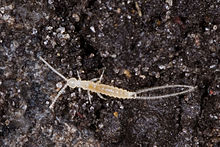
Back داخليات الفك Arabic داخليات الفك ARZ Gizliçənəlilər Azerbaijani Скрытнасківічныя Byelorussian Entògnats Catalan Entognatha CEB Skrytočelistní Czech Sackkiefler German Entognatha English Entognatha Esperanto
| Entognatha | |
|---|---|

| |
| Campodea staphylinus | |
| Klasifikasi ilmiah | |
| Domain: | |
| Kerajaan: | |
| Filum: | |
| Subfilum: | |
| Kelas: | Entognatha
|
| Subkelas beserta ordo | |
| |
Entognatha adalah kelas arthropoda tak bersayap dan ametabola, yang bersama dengan serangga membentuk subfilum Hexapoda.[1][2] Mulut mereka entognathous (ditarik ke dalam kepala), tidak seperti serangga.[1] Entognatha bersifat apterous (tidak bersayap). Kelas ini berisi subkelas Collembola[3], serta dua ordo tanpa subkelas yakni Diplura[4] dan Protura[5]. Ketiga kelompok tersebut secara historis bersatu dengan ordo Thysanura yang sekarang sudah usang untuk membentuk kelas Apterygota, tetapi sejak itu diketahui bahwa kondisi hewan ini telah berevolusi secara independen dari serangga, dan secara independen dalam setiap ordo.[6] Perintah tersebut mungkin tidak terkait erat, dan Entognatha sekarang dianggap sebagai kelompok polifili.[2]
- ^ a b David A. Grimaldi & Michael S. Engel (2005). "Arthropods and the origin of insects". Evolution of the Insects. Cambridge University Press. hlm. 93–118. ISBN 978-0-521-82149-0.
- ^ a b P. J. Gullan, Peter Cranston (2010). "Insect systematics: phylogeny and classification". The Insects: an Outline of Entomology (edisi ke-4th). John Wiley and Sons. hlm. 189–222. ISBN 978-1-4443-3036-6.
- ^ Ospina-Sánchez, C. M.; Soto-Adames, F. N.; González, G. (2020). "Checklist and distribution of Collembola from Greater Puerto Rico". Biodiversity Data Journal. 8: e52054. doi:10.3897/BDJ.8.e52054. PMC 7365838
 . PMID 32733139.
. PMID 32733139.
- ^ Sendra, Alberto; Jiménez‐Valverde, Alberto; Selfa, Jesús; Reboleira, Ana Sofia P. S. (2021). "Diversity, ecology, distribution and biogeography of Diplura". Insect Conservation and Diversity. 14 (4): 415–425. doi:10.1111/icad.12480
 .
.
- ^ Galli, L.; Shrubovych, J.; Bu, Y.; Zinni, M. (2018). "Genera of the Protura of the World: Diagnosis, distribution, and key". ZooKeys (772): 1–45. doi:10.3897/zookeys.772.24410
 . PMC 6045683
. PMC 6045683  . PMID 30018507.
. PMID 30018507.
- ^ Alessandro Minelli (2009). "A gallery of the major bilaterian clades". Perspectives in Animal Phylogeny and Evolution. Oxford University Press. hlm. 71–109. ISBN 978-0-19-856620-5.
© MMXXIII Rich X Search. We shall prevail. All rights reserved. Rich X Search